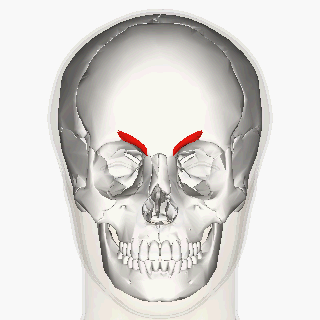Superior to the mouth are the Levator muscles.
Levator Anguli Oris( lying underneath the Levator Labii Superioris)
The Levator Labii Superioris has a medial portion which continues superior toward the corner of the eye.
The medial fiber is known as the Levator Labii Superioris Alaeque nasi muscle.
The levator labii superioris (or quadratus labii superioris)
is a muscle of the human body used in facial expression. It is a broad sheet,
the origin of which extends from the side of the nose to the zygomatic bone.
Its medial fibers form the angular head, which arises by a pointed
extremity from the upper part of the frontal process of the maxilla and passing
obliquely downward and lateralward divides into two slips.
One of these is inserted into the greater alar cartilage and skin of the
nose; the other is prolonged into the lateral part of the upper lip, blending
with the infraorbital head and with the Orbicularis oris.
The intermediate portion or infraorbital head arises from the lower
margin of the orbit immediately above the infraorbital foramen, some of its
fibers being attached to the maxilla, others to the zygomatic bone.
Its fibers converge, to be inserted into the muscular substance of the upper
lip between the angular head and the Caninus.
The lateral fibers, forming the zygomatic head, arise from the malar
surface of the zygomatic bone immediately behind the zygomaticomaxillary suture
and pass downward and medialward to the upper lip.
The two Zygomaticus,minor and major,extend from the lateral and posterior portion of the Zygomatic bone( far back on the cheek and attach on the oris and lip tissue.
There are two sections of the Obicularis Oris muscle, i.s., the palpebral section (eyelids) and orbital section(sheathing out the socket anteriorly.
Medial and extending from the bridge of the nose lateraly toward either side is the Nasal muscle


Just above the obicularis muscle is a angled fibrous section of muscle that covers the glabellar swelling.
It is known as the Corrugator muscle.
The
Corrugator supercilii is a small, narrow, pyramidal muscle,
placed at the medial end of the eyebrow, beneath the Frontalis and just above Orbicularis
oculi.
It arises from the medial end of the superciliary arch; and its fibers pass
upward and laterally, between the palpebral and orbital portions of the
Orbicularis oculi, and are inserted into the deep surface of the skin, above
the middle of the orbital arch.
The Corrugator draws the eyebrow downward and medially,
producing the vertical wrinkles of the forehead. It is the “frowning” muscle,
and may be regarded as the principal muscle in the expression of suffering].
It also contracts in order to prevent high sun glare, pulling the eyebrows
toward the bridge of the nose, making a roof over the area above the middle
corner of the eye and typical forehead furrows.



